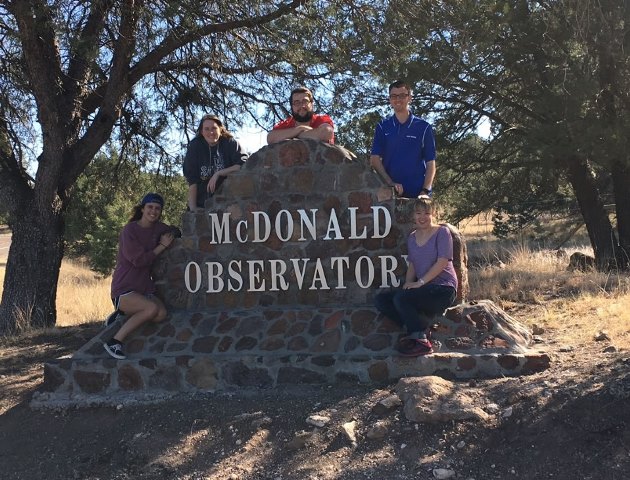Baylor Physics Department Sends First Group of Students to McDonald Observatory

L-R: Rachel (Rocky) Katch, Kerrington Moore, Brynna Neff, Taylor Robinett, Matthew Zakrzewski.
Follow us on Twitter: @BaylorUMedia
Media contact: Tonya Lewis, (254) 710-4656
WACO, Texas (May 24, 2017) – Students in Baylor University’s “Topics in Astronomy” class took a break from the classroom last semester to visit McDonald Observatory in Fort Davis, Texas. The hands-on experience with observing the night sky gave them a better understanding of what the daily, or nightly, life of an astronomer is really like.
Barbara Endl, Ph.D., a lecturer in Baylor University’s department of physics, reached out to contacts at McDonald Observatory to organize the trip in March give her students hands-on experience with the process of observing the night sky.
“They seem to have enjoyed it a lot because it’s really a professional observatory,” Endl said. “We usually have to write observing proposals to get time in those telescopes.”
In fact, Endl asked her students to write their own observing proposals for a project, so they would have a better understanding of the preparation typically required to view the night sky in an observatory. They also calibrated the telescopes themselves, gathered data and wrote papers on their findings.
Brynna Neff, an upcoming senior in the astrophysics department, said that although the information she learned in the classroom was beneficial, having the chance to conduct real research gave her a better idea of the research process.
“It was such a good experience and unlike anything I have done in other classes,” Neff said. “This experience gave me a better picture of what research in astronomy is like, and was actually part of the reason I decided to pursue a career in this field.”
According to Endl, the resources at the McDonald Observatory combined with optimal viewing conditions gave students a clear view of the night sky that they would never experience in a big city.
“The site was chosen because of the altitude and the lack of light pollution. McDonald Observatory is considered the darkest sky in the continental United States, so you cannot get any darker than that,” Endl said. “You get to see much more than if you were just walking outside because there is less contamination from pretty much everything.”
The students in Endl’s “Topics in Astronomy” class viewed spiral galaxies, nebulas and transiting extra-solar planets through the Otto Struve telescope, which has a diameter of 2.1 meters.
Most of Endl’s research focuses on pulsating white dwarfs. She said the observatory trip gave her the chance to observe objects that she doesn’t usually focus on, like the Crab Nebula.
“The Crab Nebula is actually the remnant of a massive star that exploded a thousand years ago. What we see is what’s left over from this supernova event. It was actually seen by the naked eye by the Chinese in the year 1054, and other civilizations reported it independently,” Endl said.
Five of the six students in Endl’s class were able to attend the field trip, but Endl said she wanted to make sure that not even one student missed out. Endl invited the student who missed the trip to her home for the chance to experience a night sky observation.
“The student who didn’t go actually came to my house and we observed together. I wanted her to have an experience with remote observing, too,” Endl said.
Endl said she considered the trip a success and plans to return next year with another class.
by Kassidy Woytek , student newswriter, (254) 710-6805
ABOUT BAYLOR UNIVERSITY
Baylor University is a private Christian University and a nationally ranked research institution. The University provides a vibrant campus community for more than 16,000 students by blending interdisciplinary research with an international reputation for educational excellence and a faculty commitment to teaching and scholarship. Chartered in 1845 by the Republic of Texas through the efforts of Baptist pioneers, Baylor is the oldest continually operating University in Texas. Located in Waco, Baylor welcomes students from all 50 states and more than 80 countries to study a broad range of degrees among its 12 nationally recognized academic divisions.
ABOUT BAYLOR COLLEGE OF ARTS & SCIENCES
The College of Arts & Sciences is Baylor University’s oldest and largest academic division, consisting of 25 academic departments and 13 academic centers and institutes. The more than 5,000 courses taught in the College span topics from art and theatre to religion, philosophy, sociology and the natural sciences. Faculty conduct research around the world, and research on the undergraduate and graduate level is prevalent throughout all disciplines. Visit www.baylor.edu/artsandsciences.